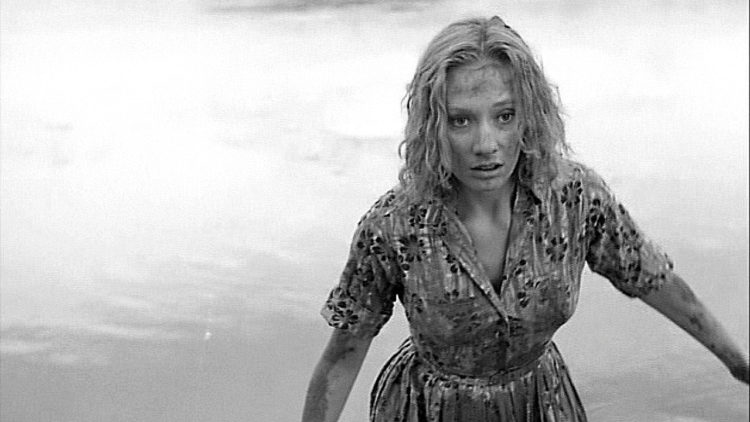
I have a weird relationship with the 1962 film Carnival of Souls. Part of the film was shot in Lawrence, Kansas, where I live. It was the director Herk Harvey’s only feature film, although he made many films for the industrial movie company Centron Corporation.
The movie is a certifiable classic, having seen release as part of the Criterion Collection, with a plethora of special features — many of which highlight the locations, quite a few few of which I pass by on a daily basis. It makes Carnival of Souls, for all its dreamlike (if not nightmarish) imagery, something very real to me. Hell, the film’s boarding house is in my neighborhood.

Per Criterion, Carnival of Souls is the story of “a young woman in a small Kansas town who survives an accident during a drag race, then agrees to take a job as a church organist in Salt Lake City. En route, she is haunted by a bizarre apparition that compels her toward an abandoned lakeside pavilion.”
It’s frightening, but not due to any amount of gore or violence. Carnival of Souls is more of a psychological piece, but even that’s pushing it. Essentially, Harvey’s movie looks and feels really creepy, because it’s as if everything is taking place within a bad dream. Mary, the woman who survives the accident — in all truth, the car drives off a bridge into the Kansas River — goes through life, working as a church organist and living in a boarding house, but is constantly beset by visions of a ghoulish figure (played by director Harvey) and a pavilion in the middle of a lake.

All the while, there’s haunting organ music, which ties it into 1973’s Messiah of Evil. As Mondo Digital describes, that film’s “experimental music score is also a major plus with discordant synthesizer droning weaving through the nighttime scenes and greatly enhancing the overall feeling of unease.”
To that end, Messiah of Evil is spiritual kin with Carnival of Souls. It’s also akin to Souls in quite a few other ways: it’s set in a small town, there’s a lot of water, and the woman at the heart of it is very troubled and confused by the mysterious goings-on. In the small ocean-side California town of Point Dune, Arletty has come to find out what’s happened to her father.

In Messiah, unlike Souls, the madness is something which takes hold in an actual, physical manner. The town is visibly being turned into something mad, whereas in Souls, Mary is merely beset by visions. Interestingly enough, both of the women inevitably transform, but the process by which they do it quite different, although the end for Mary and Arletty both is quite dire.
Souls is more of an overall sort of terror than Messiah, however. While the scenes in the pavilion are disconcerting, the film as a whole doesn’t really have any scenes which really stand out overall, other than a particularly wild scene wherein Mary is playing the church organ while the ghoulish figure dances with the other nightmares in the pavilion. Much like a dream, it’s a series of similar events, all of which seem to be leading to some greater thing, while being difficult to set properly into words.

For Messiah of Evil, however, there are two extraordinarily disconcerting scenes — one in a supermarket, another in a movie theater — wherein each of the two women Arletty meets shortly after getting to Point Dune are attacked and devoured by the changing denizens of the town. They’re almost completely free of dialogue, and play out like nightmares.
The scene in the supermarket is used to great effect in Thom Andersen’s 2003 video essay, Los Angeles Plays Itself. According to Nate Bell of the Los Angeles Weekly, “Andersen may have inadvertently boosted its reputation when he edited it into his celebrated documentary,” further explaining that, “Of the zillions of horror films cluttering the public domain, Messiah of Evil stands out like a severed thumb.”

Taken separately, Souls and Messiah are dreamlike, nigh-nightmarish films, but when paired together for viewing, it’s as if these movies made a decade apart sprang from the same mind. Maybe Willard Huyck and Gloria Katz (the couple who co-directed and wrote Messiah of Evil) were psychically connected to Herk Harvey in some way, or maybe it’s just that once every ten years or so, someone figures out how to tap into the hallucinatory madness that is the subconscious, and really create something which will stick with the viewer.
Carnival of Souls and Messiah of Evil are readily available pretty much everywhere, as they both appear to be public domain, but there’s also a really nice Criterion Collection Blu-ray of Carnival of Souls and a Code Red Blu of Messiah of Evil. You can watch both streaming below in less-robust (but still watchable) versions.




2 Comments
Comments are closed.